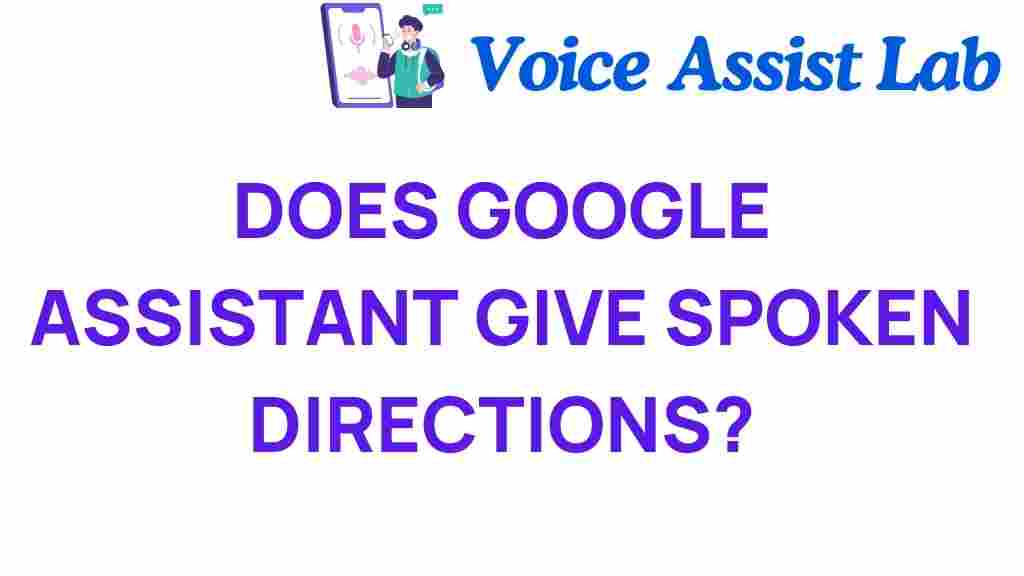Unlocking the Secrets: Does Google Assistant Provide Spoken Directions?
In today’s fast-paced digital world, smart assistants have become an integral part of our daily lives. Among them, Google Assistant stands out as a powerful tool that offers a range of functionalities, including spoken directions for navigation. With the rise of voice technology and digital assistants, many users are eager to understand how to make the most of these features. In this article, we will explore how Google Assistant provides spoken directions, enhancing the user experience and making navigation simpler and more efficient.
Understanding Google Assistant and Spoken Directions
Google Assistant is a voice-activated digital assistant developed by Google, capable of performing various tasks through voice commands. With its advanced voice recognition technology, Google Assistant can understand and respond to user queries, making it an essential tool for navigation. Spoken directions are a core feature, allowing users to receive turn-by-turn instructions without needing to look at their devices.
Here are some key features of Google Assistant related to spoken directions:
- Voice Activation: Users can activate Google Assistant by saying “Hey Google” or “OK Google.”
- Integration with Maps: Google Assistant works seamlessly with Google Maps to provide real-time navigation.
- Hands-Free Operation: Users can receive directions while driving, ensuring safety and focus on the road.
How to Use Google Assistant for Spoken Directions
Utilizing Google Assistant for navigation is straightforward. Here’s a step-by-step guide to getting spoken directions:
Step 1: Activate Google Assistant
To start, you need to activate Google Assistant. You can do this by:
- Using the voice command “Hey Google.”
- Pressing the Assistant button on your device (if available).
Step 2: Request Directions
Once activated, you can ask for directions. Here are a few examples of how to phrase your request:
- “Give me directions to [destination].”
- “Navigate to [destination].”
- “How do I get to [destination]?”
Step 3: Choose Your Mode of Transportation
Google Assistant allows you to specify your mode of transportation. You can ask for:
- Driving Directions: “Get driving directions to [destination].”
- Walking Directions: “Navigate to [destination] on foot.”
- Transit Directions: “How do I get to [destination] using public transport?”
Step 4: Follow the Spoken Directions
After your request, Google Assistant will provide you with spoken directions. You will hear turn-by-turn instructions as you navigate. Make sure to keep your device visible or use a car mount for safety while driving.
Enhancing Your User Experience with Google Assistant
To maximize your experience with Google Assistant and spoken directions, consider the following tips:
- Customize Your Settings: Tailor the settings in the Google Assistant app to suit your preferences, such as voice selection and navigation options.
- Keep Your Device Updated: Regular updates can improve performance and add new features.
- Use Routines: Create routines that include navigation commands for a more streamlined experience.
Troubleshooting Common Issues with Google Assistant Directions
While Google Assistant is a robust tool, users may encounter issues. Here are some common problems and solutions:
Issue 1: Google Assistant Doesn’t Respond
If Google Assistant fails to respond, try the following:
- Ensure your device’s microphone is working correctly.
- Check your internet connection.
- Restart your device.
Issue 2: Spoken Directions are Inaccurate
If you receive inaccurate directions:
- Verify the destination you provided.
- Check for any recent changes in your area that may affect routes.
- Consider updating the Google Maps app.
Issue 3: Google Assistant Doesn’t Understand My Commands
If Google Assistant is struggling to understand your requests:
- Speak clearly and avoid background noise.
- Try rephrasing your command.
- Check your language settings to ensure they match your spoken language.
Benefits of Using Google Assistant for Navigation
There are numerous benefits to using Google Assistant for spoken directions:
- Increased Safety: Hands-free navigation minimizes distractions while driving.
- Real-Time Updates: Google Assistant provides real-time traffic updates and rerouting options.
- Accessibility: Voice technology allows users with disabilities to navigate more easily.
Comparing Google Assistant with Other Smart Assistants
While Google Assistant excels in navigation, it’s worth comparing its features with other smart assistants:
- Siri: Apple’s Siri also offers navigation but is limited to Apple Maps.
- Alexa: Amazon’s Alexa provides navigation features primarily through third-party skills.
- Cortana: Microsoft’s Cortana has reduced focus on navigation in recent updates.
Overall, Google Assistant shines in the realm of spoken directions and navigation due to its integration with Google Maps and real-time capabilities.
The Future of Voice Technology in Navigation
As voice technology evolves, we can expect even more advanced features from digital assistants like Google Assistant. Key areas of development may include:
- Natural Language Processing: Improved understanding of complex commands and context.
- Enhanced Personalization: Tailoring navigation experiences based on user preferences and habits.
- Integration with Smart Home Devices: Coordinating navigation with home automation for a seamless experience.
For more insights into the latest developments in voice technology, check out this technology guide.
Conclusion
Google Assistant has transformed the way we navigate our world, making it easier and safer to get from point A to point B with spoken directions. By leveraging voice technology, users can enjoy a hands-free experience that enhances their overall user experience. As digital assistants continue to evolve, the future looks promising for innovations in navigation and beyond. If you haven’t explored Google Assistant’s spoken directions yet, now is the perfect time to unlock the secrets of this powerful tool!
This article is in the category Guides and created by VoiceAssistLab Team
